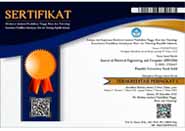M. Adriansa, L. Yulianti, and L. Elfianty, “Analisis Kepuasan Pelanggan Menggunakan Algoritma C4.5,” J. Tek. Inform. UNIKA St. Thomas, vol. 07, no. 21, pp. 115–121, 2022.
M. R. H. M. Saleh and I. W. Sudiarsa, “Rancang Bangun Pendeteksi Monitoring Gas LPG Berbasis Mikrokontroller dan Notifikasi Telegram Messenger,” J. Krisnadana, vol. 3, no. 1, pp. 310–319, 2023.
M. Siddik, H. Hendri, R. N. Putri, Y. Desnelita, and G. Gustientiedina, “Klasifikasi Kepuasan Mahasiswa Terhadap Pelayanan Perguruan Tinggi Menggunakan Algoritma Naïve Bayes,” INTECOMS J. Inf. Technol. Comput. Sci., vol. 3, no. 2, pp. 162–166, 2020.
R. Andriana and E. Prasetyaningrum, “Sistem Informasi Pendistribusian Gas Lpg Di Pt . Budi Bhakti Kalimantan Berbasis Web,” J. Penelit. Dosen Fikom, vol. 10, no. 1, pp. 1–11, 2019.
S. Laitera, W. A. Dewa, and S. Arifin, “Penerapan Sistem Alarm Berbasis Arduino Uno Untuk Mendeteksi Kebocoran Gas LPG,” J. Janitra Inform. dan Sist. Inf., vol. 2, no. 2, pp. 96–106, 2022.
R. Alfiani and Y. Umaidah, “Prediksi Kepuasan Customer Terhadap Performance Terapis Baby Massage Menggunakan Algoritma Naive Bayes,” Bina Insa. Ict J., vol. 9, no. 1, p. 83, 2022.
P. L. Lokapitasari Belluano, I. Indrawati, H. Harlinda, F. A. . Tuasamu, and D. Lantara, “Analisis Tingkat Kepuasan Pengguna Sistem Informasi Perpustakaan Menggunakan Pieces Framework,” Ilk. J. Ilm., vol. 11, no. 2, pp. 118–128, 2019.
E. T. Naldy and A. Andri, “Penerapan Data Mining Untuk Analisis Daftar Pembelian Konsumen Dengan Menggunakan Algoritma Apriori Pada Transaksi Penjualan Toko Bangunan MDN,” J. Nas. Ilmu Komput., vol. 2, no. 2, pp. 89–101, 2021.
Oon Wira Yuda, Darmawan Tuti, Lim Sheih Yee, and Susanti, “Penerapan Penerapan Data Mining Untuk Klasifikasi Kelulusan Mahasiswa Tepat Waktu Menggunakan Metode Random Forest,” SATIN - Sains dan Teknol. Inf., vol. 8, no. 2, pp. 122–131, 2022.
S. Lestari, A. Akmaludin, and M. Badrul, “Implementasi Klasifikasi Naive Bayes Untuk Prediksi Kelayakan Pemberian Pinjaman Pada Koperasi Anugerah Bintang Cemerlang,” PROSISKO J. Pengemb. Ris. dan Obs. Sist. Komput., vol. 7, no. 1, pp. 8–16, 2020.
Sutisna and N. M. Yuniar, “Klasifikasi Kualitas Air Bersih Menggunakan Metode Naïve baiyes,” J. Sains dan Teknol., vol. 5, no. 1, pp. 243–246, 2023.
I. Amillina and A. Qoiriah, “Penerapan Algoritma Naïve Bayes Dalam Klasifikasi Tingkat Kepuasan Siswa Terhadap Pembelajaran Daring,” J. Ilm. Teknol. Inf. dan Robot., vol. 3, no. 2, pp. 16–23, 2021.
N. Asmiati and Fatmawati, “Penerapan Algoritma Naive Bayes Untuk Mengklasifikasi Pengaruh Negatif Game Online Bagi Remaja Milenial,” JTIM J. Teknol. Inf. dan Multimed., vol. 2, no. 3, pp. 141–149, 2020.
A. C. Khotimah and E. Utami, “Comparison Naive Bayes Classifier, K-Nearest Neighbor, and Support Vector Machine in the classification of individual on twitter account,” J. Tek. Inform., vol. 3, no. 3, pp. 673–680, 2022.
A. Nugroho and Y. Religia, “Analisis Optimasi Algoritma Klasifikasi Naive Bayes menggunakan Genetic Algorithm dan Bagging,” J. RESTI (Rekayasa Sist. dan Teknol. Informasi), vol. 5, no. 3, pp. 504–510, 2021.
K. Kadarsih and S. Andrianto, “Membangun Website SMA PGRI Gunung Raya Ranau Menggunakan PHP dan MYSQL,” JTIM J. Tek. Inform. Mahakarya, vol. 03, no. 2, pp. 37–44, 2022.

 (Universitas Katolik De La Salle Manado)
(Universitas Katolik De La Salle Manado) 








